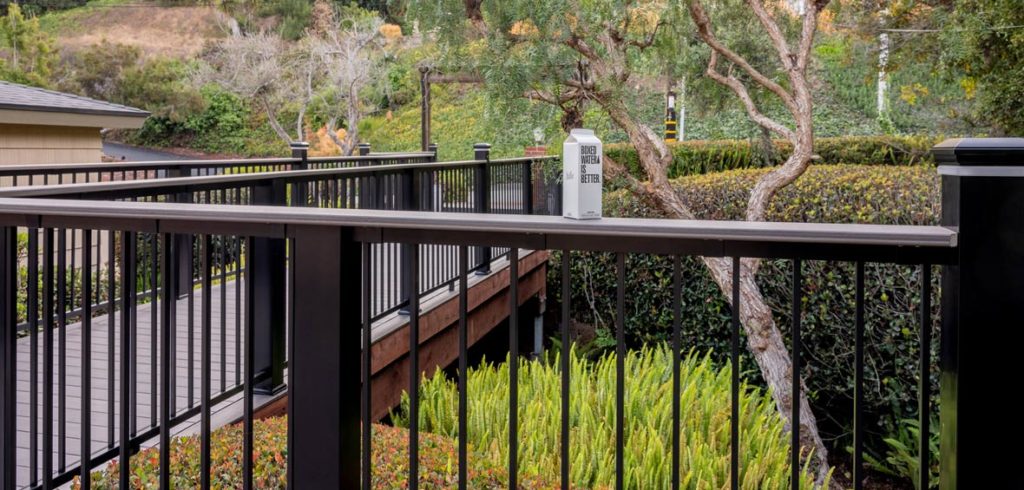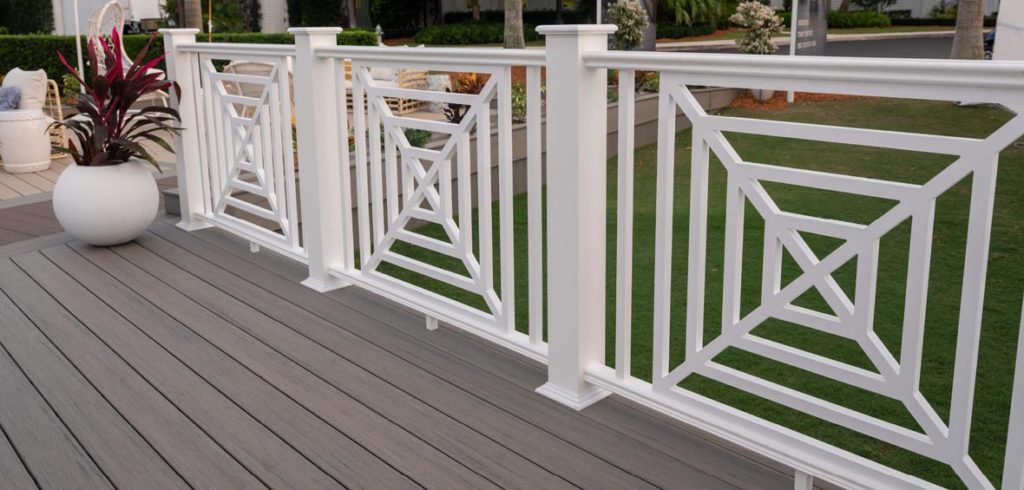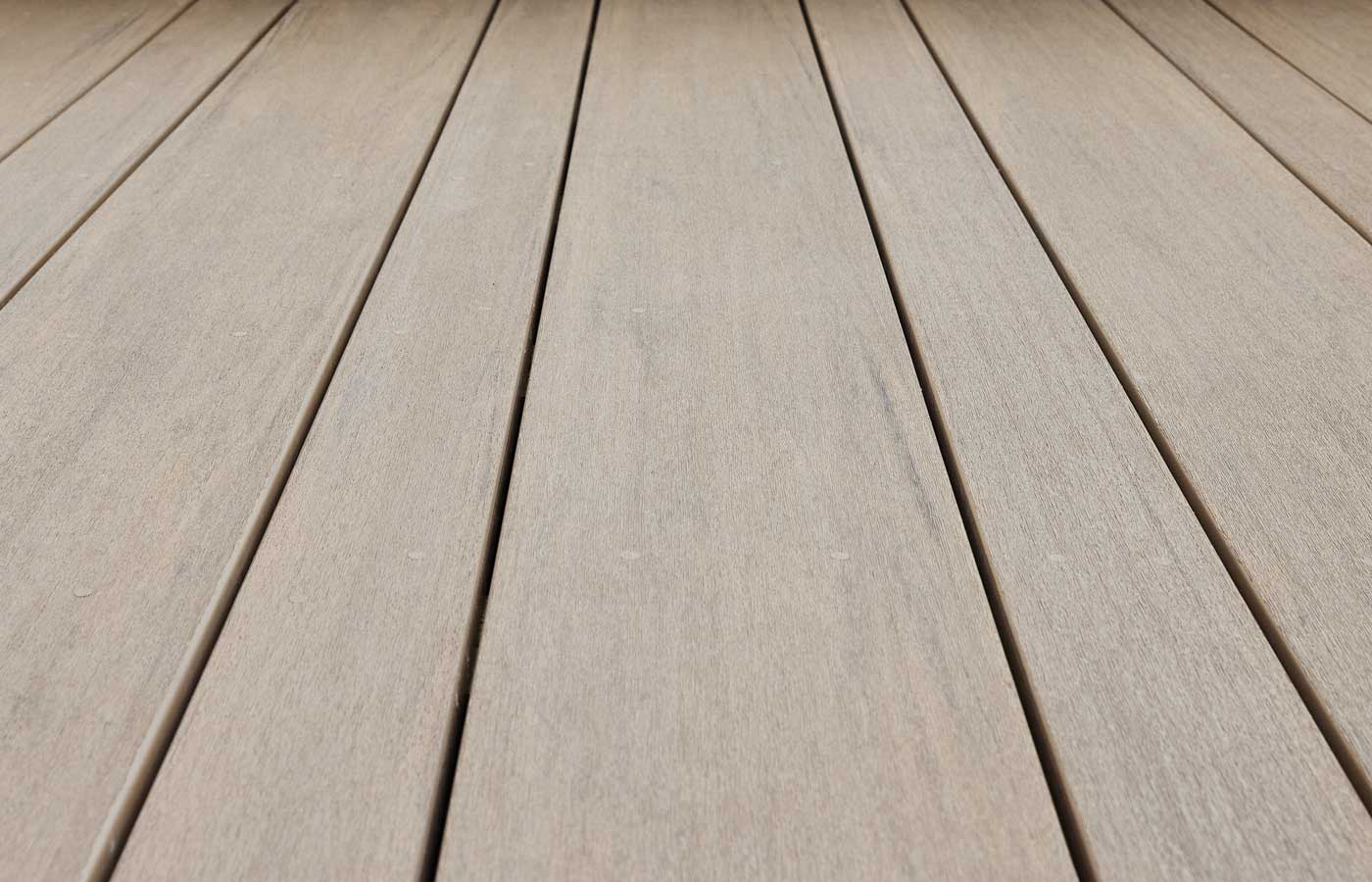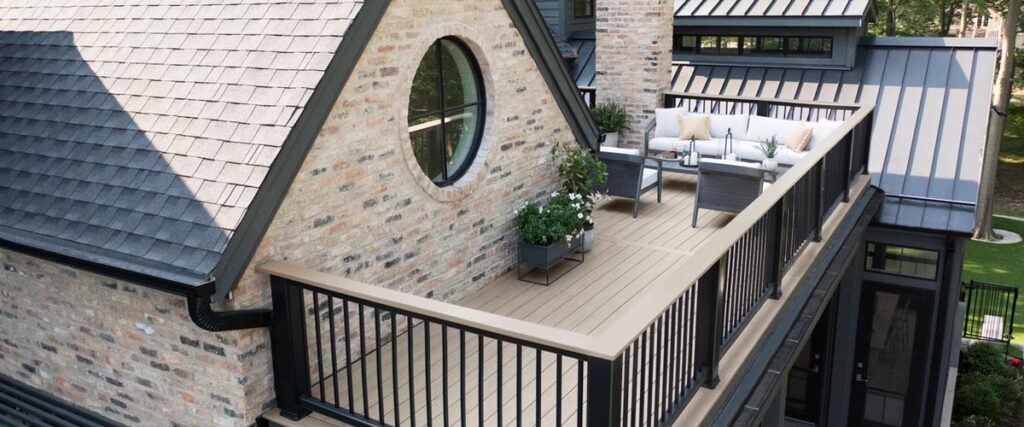Drink rails, cable infills, powder-coated aluminum posts, and classic wood balusters are just a few of the many options you have for your deck’s railing. Each part of your railing can vary by material and style, so it may be overwhelming to look through the options.
We’ve gathered some of the most popular types of deck railings, including infill styles and railing materials, so you have all of the information you need to design your dream deck.
Deck Railing Options:
Deck railings come in a variety of materials, including composite, PVC, wood, and aluminum. You can also choose between different infill and top rail designs for a true-to-you look.
Types of Railing Designs:
1. Cable Railing: Modern and Minimalist

Cable railing infills have burst in popularity for their simple and sleek design. The wire cables connect neighboring posts in a horizontal design, or may be installed vertically between top and bottom rails. This design provides a safe perimeter without obstructing your favorite views.
| Pros: | Cons: |
|---|---|
| • Unobstructed views • Minimalist design aesthetic • Durable and safe | • Higher cost • May be restricted by local law |
2. Craftsman Railing: Privacy With Polish

The craftsman style showcases how beautiful wood workmanship can look with traditional designs and gorgeous grain patterns. There’s not so much a go-to craftsman rail design as much as it’s an aesthetic you can use to recreate the charm of expertly carved woods for your deck or porch.
Solid, traditional hardwood railing posts can certainly do the job. Of course, you can install a composite railing with natural grain textures and colors for a low-maintenance accent to your craftsman-style home. You can also take advantage of additional composite features, like drink rails to add usability.
| Pros: | Cons: |
|---|---|
| • Durable design and craftsmanship • Traditional look and feel | • Higher costs for true craftsmanship • More maintenance for real wood railings |
3. Drink Rails: Function and Flair

Drink rails provide a flat surface on your top rails for people to set their glasses down or lean back and relax while chatting on the deck. It’s a simple addition to your railing material of choice, like the aluminum railing featured here, but adds elegance and functionality to your deck. The flat-top can also support decor, like simple railing planters or tea lights.
| Pros: | Cons: |
|---|---|
| • Adds additional functionality to your railing • Colors and styles available to match your deck | • Flat surface can collect debris |
4. Glass Panels: Sleek and Stylish

Glass panels are another opportunity to install a stylish and contemporary railing without obstructing your views. Its gaps are smaller than other popular railing infills, which can be a great perk for families with small kids or pets — just know that little fingerprints and noseprints are part of the package.
| Pros: | Cons: |
|---|---|
| • Gapless designs provide a safe solid barrier • Unobstructed views • Contemporary, high-end look | • Costly to purchase and install • Needs to be cleaned frequently • Can heat decks with a greenhouse effect |
5. Square Web Panels: Classic and Joyful

Square web composite railings offer a geometric design similar to what some manufacturers call Chippendale railing, featuring repeating diamond or square patterns. The simplified design won’t overwhelm your home’s look while still providing an interesting and elevated design. There’s also an element of privacy without completely obscuring the view, which is great for backyard pool railing.
| Pros: | Cons: |
|---|---|
| • Interesting patterns to elevate your design • Easy-to-install panels | • May obstruct your view • Unique design may be hard to replace |
6. Wrought Iron Look: Simple and Sophisticated

The wrought iron look is a go-to for its timeless sophistication, but more often than not, your neighbor’s wrought iron fence is actually made of powder-coated aluminum. Real wrought iron is heavy and extremely vulnerable to rust. Powder-coated aluminum brilliantly mimics the style with less labor required to install and maintain the railing.
| Pros: | Cons: |
|---|---|
| • Timeless and sophisticated style • Sturdy and decorative • Aluminum alternatives require little maintenance | • True wrought iron is heavy and prone to rust • Powder coating on aluminum can be scratched |
Deck Railing Materials
The best part about modern deck design is the wide range of choices homeowners have to customize their deck’s materials and look. You have the option to build a deck entirely to your dream aesthetic, or to prioritize sustainable materials as part of your lifestyle.
To help you break down the options and make the right decision, here’s an overview of the deck railing materials you have to choose from.
7. Composite Materials
Composite railings are a low-maintenance alternative to real wood railings that don’t sacrifice any of the charm natural wood has to offer. With real wood look and feel, and a variety of stunning colors to choose from, composite is an affordable and versatile material option for your deck.
| Pros: | Cons: |
|---|---|
| • Affordable • Versatile styles • Low-maintenance material | • Not as durable as metal materials • Limited ability to paint or repair |
8. PVC Materials
PVC railings can withstand the elements and make an extra-affordable addition to your deck design. They’re lightweight and smooth rather than grooved, so they won’t look like wood, but they are easy to clean and care for. TimberTech’s PVC railings are built with an aluminum core for enhanced durability, but other vinyl railings may not be as durable as composite.
| Pros: | Cons: |
|---|---|
| • Low-maintenance material • Weatherproof • Affordable • Versatile styles | • Durability varies between manufacturers • Doesn’t have the look or feel of real wood |
9. Metal Materials
There are a number of metals you can use for your railing, including steel, aluminum, and iron. Each has its own pros and cons, though powder-coated aluminum is typically the top metal railing choice for outdoor projects. It’s more weatherproof, affordable, and low maintenance than other metals. Of course, you can choose the material that makes sense for your home and environment.
| Pros: | Cons: |
|---|---|
| • Weather-resistant and durable • Lightweight • Powder coating comes in a variety of colors | • Powder coating may scratch • Not recommended to paint over powder coating |
10. Wood Materials
The beauty of wood can be hard to beat, though it’s certainly not impossible. You have no shortage of wood material options, either. Ipe wood is top-of-the-line quality, and hardwoods are a craftsman’s favorite, but pressure-treated lumber works well, too.
Wood decks and railings are stunning, but they also have the highest maintenance needs of any other railing type. Depending on your wood preference and when you’re building, material costs can also get pricey.
| Pros: | Cons: |
|---|---|
| • Lower upfront costs, but prices vary • Can be repaired and painted | • High-maintenance material • Vulnerable to rot and weathering |
Your choice of deck railing type can complete your whole aesthetic, offering a seamless view of your city with glass or cable infills, or showing off your eye for design with a chic Chippendale pattern. A little inspiration and knowledge can help you determine which is best for your lifestyle.
Still comparing a few materials or colors? Order TimberTech decking samples to find your perfect match.






